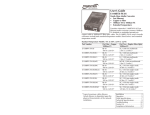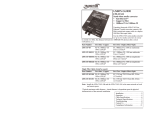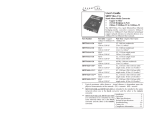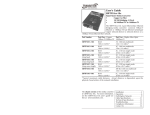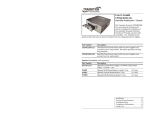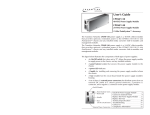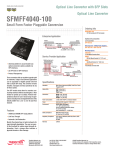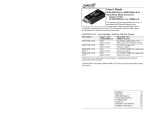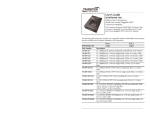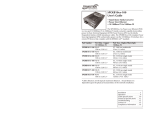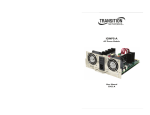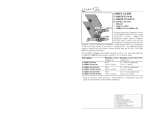Download Transition Networks SCSCF30XX-10X User's Manual
Transcript
User’s Guide SCSCF30xx-10x Stand-Alone Device • DS3 or T3 / E3 • Coax (BNC) to Fiber Transition Networks SCSCF30xx-10x series Devices encode and decode DS3 or E3 coax copper signals over fiber optic cable to extend the distance and transmission reliability of highspeed DS3 or E3 data traffic. The SCSCF30xx10x also connects remote locations via T3/E3 cable. Part Number SCSCF3011-100 Port One - Copper 75 ohm coax (BNC) SCSCF3013-100 75 ohm coax (BNC) SCSCF3014-100 75 ohm coax (BNC) SCSCF3015-100 75 ohm coax (BNC) Port Two - Duplex Fiber-Optic ST, 1300 nm multimode 2 km (1.2 miles)* SC, 1300 nm multimode 2 km (1.2 miles)* SC, 1310 nm singlemode 20 km (12.4 miles)* SC, 1310 nm singlemode 40 km (24.8 miles)* SCSCF3016-100 75 ohm coax (BNC) SC, 1310 nm singlemode 60 km (37.3 miles)* SCSCF3017-100 75 ohm coax (BNC) SC, 1550 nm singlemode 80 km (49.7 miles)* SCSCF3018-100 75 ohm coax (BNC) MT-RJ, 1300 nm multimode 2 km (1.2 miles)* SCSCF3019-100 75 ohm coax (BNC) LC, 1310 nm single mode 20 km (12.4 miles)* SCSCF3029-100 75 ohm coax (BNC) SC, 1310 mn (TX)/1550 nm (RX) 20 km (12.4 miles)* SCSCF3029-101 75 ohm coax (BNC) SC, 1550 mn (TX)/1310 nm (RX) 20 km (12.4 miles)* SCSCF3029-100 and -101 are intended to be installed in the same network where one is the local converter and the other is the remote converter. * Typical maximum cable distance. Actual distance is dependent upon the physical characteristics of the network. Note: The CCSCF30xx-10x model is the chassis version of the Device. For more information, see the CCSCF30xx-10x user’s guide on-line at www.transition.com. Installation . . . . . . . . . . . . . . . . . . . . .2 Operation . . . . . . . . . . . . . . . . . . . . . .6 Cable Specifications . . . . . . . . . . . . . .7 Technical Specifications . . . . . . . . . . .8 Troubleshooting . . . . . . . . . . . . . . . . .9 Compliance Information . . . . . . . . .12 SCSCF30xx-10x Part Number SCSCF3029-102 SCSCF3029-103 Port One - Copper 75 ohm coax (BNC) 75 ohm coax (BNC) Installation -- Continued Port Two - Single Fiber Optic SC, 1310 mn (TX)/1550 nm (RX) 40 km (24.8 miles)* CAUTION: Wear a grounding device and observe electrostatic discharge precautions when setting the configuration switches. Failure to observe this caution could result in damage to, and subsequent failure of, the Device. SC, 1550 mn (TX)/1310 nm (RX) 40 km (24.8 miles)* SCSCF3029-102 and -103 are intended to be installed in the same network where one is the local converter and the other is the remote converter. SCSCF3039-100 75 ohm coax (BNC) Set the Configuration Switches The configuration switches are located on the side of the Device. Use a small, flatblade screwdriver to set the recessed switches. LC, 1300 mn multimode 2 km (1.2 miles)* *Typical maximum cable distance. Actual distance is dependent upon the physical characteristics of the network: (TX) = transmit, (RX) = receive. Switch 1 -- Select DS3 or E3 up up - Supports a DS3 interface. Optional Accessories (sold separately) down - Supports a E3 interface. Part Number Description SPS-1872-SA Optional External Power Supply; 18-72VDC Stand-Alone Output: 12.6VDC, 1.0 A DS3 down SPS-1872-PS Optional External Power Supply; 18-72VDC Piggy-back; Output: 12.6VDC, 1.0 A E-MCR-04 12-Slot Device Rack (includes universal internal power supply) 17 x 15 x 5 in. (432 x 381 x 127 mm) WMBL Optional Wall Mount Brackets; 4.0 in. (102 mm) WMBV Optional Vertical Mount Bracket; 5.0 in. (127 mm) WMBD Optional DIN Rail Mount Bracket; 5.0 in. (127 mm) WMBD-F Optional DIN Rail Mount Bracket (flat); 3.3in. (84 mm) E3 Switch 2 -- Coax Line Build Out (DS3 only) up up - The DS3 line is set up to operate at distances up to 225 ft. (68.6 m). down - The DS3 line is set up to operate at distances greater than 225 ft. (68.6 m). <225 ft (68.6 m) down >225 ft (68.6 m) Installation Set the Loop-Back Switch up Switch 3 -- Signal on Loss of Carrier The loop-back switch is located on the front panel of the Device and is used for installation and network debugging procedures. up - Transmits an alarm indication signal (AIS) on the loss of the input carrier (unframed). To set the switch, use a small flatblade screwdriver or a similar device (see the drawing to the right). down - No signal is transmitted on the loss of the input carrier (unframed). CL CL (Coax loop-back) Enable loop-back on the local coax interface. -- (Center Position) Normal operation. FL (Fiber loop-back) Enable loop-back on the local fiber interface. FL Note: Three loop-back test scenarios are described in detail on page 10. Transmit alarm down No signal up Switch 4 -- Alarm Indication Signal (AIS) up - AIS is defined as a pattern of alternating 1’s and 0’s (unframed). Alarms = 1's and 0' down - AIS is defined as a pattern of all 1’s (unframed). down Alarm = all 1's 2 24-hour Technical Support: 1-800-260-1312 -- International: 00-1-952-941-7600 [email protected] -- Click the “Transition Now” link for a live Web chat. 3 SCSCF30xx-10x Installation -- Continued Installation -- Continued CAUTION: Wear a grounding device and observe electrostatic discharge precautions when setting the jumper. Failure to observe this caution could result in damage to, and subsequent failure of, the Device. Install the Coax Cable 1. Locate or build coax cables with female connectors installed at both ends. 2. Connect the coax cables to the Device as described: • Connect the female TX cable connector to the male TX port. • Connect the female RX cable connector to the male RX port. Connect the coax cables to the other device (switch, workstation, etc.) as described: • Connect the female TX cable connector to the male RX port. • Connect the female RX cable connector to the male TX port. Set the Coax Grounding Jumpers Note: Modify the settings for J11 and J12 only if necessary. 3. Jumpers 11 and 12 (located on the circuit board near the coax ports) provide a grounding feature so that the SCSCF30xx-10x Device complies with the G.703 specification where: • The output coax port is connected to chassis ground. • A provision to connect the input coax port to chassis ground is provided. The factory settings for these two jumpers are: Jumper 12 (jumpered) RX RX TX TX = Output coax port is connected to chassis ground. Jumper 11 (not-jumpered) = Input coax port is not connected to chassis ground. J11 No Jumper Connect the coax cable to the Media Converter as shown J12 Jumper The jumpers are located on the circuit board inside the Device housing. To set the jumpers: 1. Using a small screwdriver, remove the four (4) screws that secure the cover and carefully remove the cover from the Device. 2. Locate the jumper on the circuit board. Install the Fiber Cable 1. Locate or build fiber cables with male, two-stranded TX to RX connectors installed at both ends. 2. Connect the fiber cables to the local SCSCF30xx-10x Device as described: • Connect the male TX cable connector to the female TX port. • Connect the male RX cable connector to the female RX port. Connect the fiber cables to the remote SCSCF30xx-10x Device as described: • Connect the male TX cable connector to the female RX port. • Connect the male RX cable connector to the female TX port. 3. 4 Connect the coax cable to the other device as shown 3. Using small needle-nosed pliers or similar device, move the jumper to the desired position. (Refer to the above drawing.) 4. Carefully replace the cover on the Device and replace the four (4) screws that secure the cover to the Device. 24-hour Technical Support: 1-800-260-1312 -- International: 00-1-952-941-7600 RX RX TX TX Connect fiber cable to media converter as shown. Connect fiber cable to other device (media converter, hub, etc.) as shown [email protected] -- Click the “Transition Now” link for a live Web chat. 5 SCSCF30xx-10x Installation -- Continued Cable Specifications Power the Device Coax Cable DS3 / E3: 75 ohm coax cable with BNC connectors. Peak pulse power in DBm AC 1. Connect the barrel connector on the power adapter to the Device’s power port (located on the back of the Device). 2. Connect the power adapter plug to AC power. 3. Verify that the Device is powered by observing the illuminated LED power indicator light. Consult the user’s guide for the Transition Networks SPS1872-xx DC external power supply for powering the Device. Operation After installation, the Device should function without operator intervention. Use the status LEDs to monitor the Device operation in the network. SDF Green on The coax link is up. Green flashing The coax link is in loop-back mode. Yellow on AIS (Alarm Indication Signal) on the coax link. Green on The fiber link is up. Green flashing The fiber link is in loop-back mode. Yellow on AIS (Alarm Indication Signal) on the fiber link. PWR Green on The Device is connected to external power. TX PWR RX SDF SDC Fiber 6 TX output min: +1.25 dBm max: +3.25 dBm RX input min: -9.47 dBm max: +9.25 dBm Fiber Cable DC SDC (Decibel millwatts). Coax 24-hour Technical Support: 1-800-260-1312 -- International: 00-1-952-941-7600 Singlemode fiber (recommended): Multimode fiber (recommended): Multimode fiber (optional): 9 µm 62.5/125 µm 100/140, 85/140, 50/125 µm SCSCF3011-100 Fiber Optic Transmitter Power: Fiber Optic Receiver Sensitivity: Link Budget: 1300 nm multimode min: -19.0 dBm max: -14.0 dBm min: -30.0 dBm max: -14.0 dBm 11.0 dB SCSCF3013-100 Fiber Optic Transmitter Power: Fiber Optic Receiver Sensitivity: Link Budget: 1300 nm multimode min: -19.0 dBm max: -14.0 dBm min: -30.0 dBm max: -14.0 dBm 11.0 dB SCSCF3014-100 Fiber-optic Transmitter Power: Fiber-optic Receiver Sensitivity: Link Budget: 1310 nm singlemode min: -15.0 dBm max: -8.0 dBm min: -31.0 dBm max: -8.0 dBm 16.0 dB SCSCF3015-100 Fiber Optic Transmitter Power: Fiber Optic Receiver Sensitivity: Link Budget: 1310 nm singlemode min: -8.0 dBm max: -2.0 dBm min: -34.0 dBm max: -7.0 dBm 26.0 dB SCSCF3016-100 Fiber-optic Transmitter Power: Fiber-optic Receiver Sensitivity: Link Budget: 1310 nm singlemode min: -5.0 dBm max: 0.0 dBm min: -34.0 dBm max: -7.0 dBm 29.0 dB SCSCF3017-100 Fiber-optic Transmitter Power: Fiber-optic Receiver Sensitivity: Link Budget: 1550 nm singlemode min: -5.0 dBm max: 0.0 dBm min: -34.0 dBm max: -7.0 dBm 29.0 dB SCSCF3018-100 Fiber-optic Transmitter Power: Fiber-optic Receiver Sensitivity: Link Budget: 1300 nm multimode min: -19.0 dBm max: -14.0 dBm min: -33.5 dBm max: -14.0 dBm 14.5 dB SCSCF3019-100 Fiber-optic Transmitter Power: Fiber-optic Receiver Sensitivity: Link Budget: 1310 nm single mode min: -15.2 dBm max: -8.0 dBm min: -32.5 dBm max: -3.0 dBm 17.3 dB SCSCF3029-100 SCSCF3029-101 Fiber-optic Transmitter Power: Fiber-optic Receiver Sensitivity: Link Budget: 1310 nm (TX) / 1550 nm (RX) simplex 1550 nm (TX) / 1310 nm (RX) simplex min: -13.0 dBm max: -6.0 dBm min: -32.0 dBm max: -3.0 dBm 19.0 dB [email protected] -- Click the “Transition Now” link for a live Web chat. 7 SCSCF30xx-10x Cable Specifications -- Continued SCSCF3029-102 SCSCF3029-103 Fiber-optic Transmitter Power: Fiber-optic Receiver Sensitivity: Link Budget: 1310 nm (TX) / 1550 nm (RX) simplex 1550 nm (TX) / 1310 nm (RX) simplex min: -8.0 dBm max: -3.0 dBm min: -33.0 dBm max: -3.0 dBm 25.0 dB CSCSCF3039-100 Fiber-optic Transmitter Power: Fiber-optic Receiver Sensitivity: Link Budget: 1300 nm multimode min: -19.0 dBm max: -14.0 dBm min: -30.0 dBm max: -14.0 dBm 11.0 dB Troubleshooting If the Device fails, isolate and correct the failure by determining the answers to the following questions and then taking the indicated action: 1. • • The fiber optic transmitters on this device meet Class I Laser safety requirements per IEC-825/CDRH standards and comply with 21 CFR1040.10 and 21CFR1040.11. • • For use with Transition Networks Model SCSCF30xx-10x or equivalent DS3 / T3 = 44.7 Mb/s; E3 = 34.4 Mb/s Dimensions 3.25" x 4.7" x 1.0" (83 mm x 119 mm x 25 mm) Weight 10 oz. (283 g) approximately Power Consumption 6.0 Watts Power Supply DC Outlet 12 VDC, 0.8 Amp (minimum) Minimum output regulation: 5% MTBF (stand alone) 48,996 (MIL217F2 V5.0) (MIL-HDBD-217F) 119,854 (Bellcore7 V5.0) Environment Tmra*: Storage Temp: Humidity: Altitude: Warranty 2. FCC Class A; EN 55022 Class A; EN 55024; ANSI T1.102-1993; ETSI TBR-24; ITU-T G.703 G.823 for jitter tolerance; G.775 for loss of signal; Telecordia GR499CORE & GR-253-CORE Data Rate 0 to 50°C (32° to 122°F ) -20° to 85°C (-4° to 185°F) 5 to 95%, non condensing 0 to 10,000 feet • • • 3. Proceed to step 3. Is the SDF (Signal Detect / Fiber) LED illuminated green? NO • • • Check the fiber cables for proper connection. Verify that the TX and RX cables on the local Device are connected to the RX and TX ports, respectively, on the remote Device. Contact Tech Support: 1-800-260-1312, Int’l: 00-1-952-941-7600. YES • 4. Proceed to step 4. Is the SDC (Signal Detect / Coax) LED flashing green? YES • • The coax link is in loop-back mode. For normal operation, set the loopback switch to the center (normal) position. Contact Tech Support: 1-800-260-1312, Int’l: 00-1-952-941-7600. NO • CAUTION: Visible and invisible laser radiation when open. Do not stare into beam or view directly with optical instruments. Check the coax cables for the proper connection. Contact Tech Support: 1-800-260-1312, Int’l: 00-1-952-941-7600. YES *Manufacturer’s rated ambient temperature. Product is certified by the manufacturer to comply with DHHS Rule 21/CFR, Subchapter J applicable at the date of manufacture. Proceed to step 2. Is the SDC (Signal Detect / Coax) LED illuminated green? NO Lifetime For the most up-to-date information on the SCSCF30xx-10x Device, view the user’s guide on-line at www.transition.com. Ensure that the power adapter is the proper type of voltage and cycle frequency for the outlet. Ensure the power adapter is properly installed in the Device and in the grounded outlet. Contact Tech Support: 1-800-260-1312, Int’l: 00-1-952-941-7600. YES Technical Specifications Standards Is the PWR (Power) LED on the Device illuminated? NO 5. Proceed to step 5. Is the SDF (Signal Detect / Fiber) LED flashing green? YES • • The fiber link is in loop-back mode. For normal operation, set the loopback switch to the center (normal) position. Contact Tech Support: 1-800-260-1312, Int’l: 00-1-952-941-7600. NO • Proceed to step 6. CAUTION: Use of controls, adjustments or the performance of procedures other than those specified herein may result in hazardous radiation exposure. 8 24-hour Technical Support: 1-800-260-1312 -- International: 00-1-952-941-7600 [email protected] -- Click the “Transition Now” link for a live Web chat. 9 SCSCF30xx-10x 6. 7. Is Data Transfer Failing? YES • Is the SDC (Signal Detect / Coax) LED illuminated yellow? YES • Verify the local copper connection by starting a local copper loop-back (set the loop-back switch on the local Device to “CL”) and then use a bit error test unit at the local location to run a bit error test. A failure of the remote unit connected to the coax interface has caused an Alarm Indication Signal (AIS) on the coax interface. Correct the remote unit failure. Copper • Local Converter Fiber Remote Converter Copper Coax Remote Device Bit Error Test Unit AIS on coax link • • Copper L ocal Device B it E rror Tes t Unit Remote Converter Proceed to step 8. Is the SDF (Signal Detect / Fiber) LED illuminated yellow? YES • Fiber Contact Tech Support: 1-800-260-1312, Int’l: 00-1-952-941-7600. NO 8. Local Converter A broken coax link has caused an Alarm Indication Signal (AIS) on the fiber interface. Correct the coax link failure. Original Fault AIS on fiber link Coax • Verify the remote copper connection by starting a local copper loop-back at the remote location (set the loop-back switch on the remote Device to “CL”) and then use a bit error test unit at the remote location to run a bit error test. • Fiber Remote Converter Copper L ocal Device B it E rror Tes t Unit Local Converter Fiber Coax Contact Tech Support: 1-800-260-1312, Int’l: 00-1-952-941-7600. NO • Copper Coax Original Fault Verify the local fiber connection by starting a local fiber loop-back at the remote location (set the loop-back switch on the remote Device to “FL”) and then use a bit error test unit at the local location to run a bit error test. Copper Fiber Contact Tech Support: 1-800-260-1312, Int’l: 00-1-952-941-7600. Declaration of Conformity Name of Mfg: • Contact Tech Support: 1-800-260-1312, Int’l: 00-1-952-941-7600. NO • Proceed to step 7. Transition Networks 10900 Red Circle Drive, Minnetonka MN 55343 U.S.A. Model: SCSCF30xx-10x Series Device Part Number: SCSCF3011-100, SCSCF3013-100, SCSCF3014-100, SCSCF3015-100, SCSCF3016-100, SCSCF3017-100, SCSCF3018-100, SCSCF3019-100, SCSCF3029-100, SCSCF3029-101, SCSCF3029-102, SCSCF3029-103, SCSCF3039-100 Regulation: EMC Directive 89/336/EEC Purpose: To declare that the SCSCF30xx-10x to which this declaration refers is in conformity with the following standards. EN 55022:1998 Class A; EN 55024:1998; FCC Part 15 Subpart B; CFR 21 subpart J 61000-3-2:1995+A14:2000; 61000-3-3:1995; I, the undersigned, hereby declare that the equipment specified above conforms to the above Directive(s) and Standard(s). February, 2009 Stephen Anderson, Vice-President of Engineering 10 24-hour Technical Support: 1-800-260-1312 -- International: 00-1-952-941-7600 Date [email protected] -- Click the “Transition Now” link for a live Web chat. 11 Compliance Information CE Mark CISPR22/EN55022 Class A + EN55024 FCC Regulations This equipment has been tested and found to comply with the limits for a Class A digital device, pursuant to part 15 of the FCC rules. These limits are designed to provide reasonable protection against harmful interference when the equipment is operated in a commercial environment. This equipment generates, uses, and can radiate radio frequency energy and, if not installed and used in accordance with the instruction manual, may cause harmful interference to radio communications. Operation of this equipment in a residential area is likely to cause harmful interference, in which case the user will be required to correct the interference at the user's own expense. Canadian Regulations This digital apparatus does not exceed the Class A limits for radio noise for digital apparatus set out on the radio interference regulations of the Canadian Department of Communications. Le présent appareil numérique n'émet pas de bruits radioélectriques dépassant les limites applicables aux appareils numériques de la Class A prescrites dans le Règlement sur le brouillage radioélectrique édicté par le ministère des Communications du Canada. European Regulations Warning This is a Class A product. In a domestic environment this product may cause radio interference in which case the user may be required to take adequate measures. Achtung ! Dieses ist ein Gerät der Funkstörgrenzwertklasse A. In Wohnbereichen können bei Betrieb dieses Gerätes Rundfunkstörungen auftreten. In Diesem Fäll ist der Benutzer für Gegenmaßnahmen verantwortlich. Attention ! Ceci est un produit de Classe A. Dans un environment domestique, ce produit risque de créer des interférences radioélectriques, il appartiendra alors à l'utilsateur de prende les measures spécifiques appropriées. Contact Us Technical support is available 24 hours a day. US and Canada: 1-800-260-1312 International: 00-1-952-941-7600 Chat live via the Web with Transition Networks Technical Support. Log onto www.transition.com and click the Transition Now link. Transition Networks provides seminars via live web-based training. Log onto www.transition.com and click the Learning Center link. Ask a question anytime by sending an e-mail to our technical support staff. [email protected] Transition Networks, 10900 Red Cricle Drive, Minnetonka, MN 55343, U.S.A. telephone: 952-941-7600, toll free: 800-526-9267, fax: 952-941-2322 Trademark Notice All trademarks and registered trademarks are the property of their respective owners. Copyright Restrictions © 2001, 2004 Transition Networks. All rights reserved. No part of this work may be reproduced or used in any form or by any means - graphic, electronic, or mechanical - without written permission from Transition Networks. Printed in the U.S.A. 33216.G









